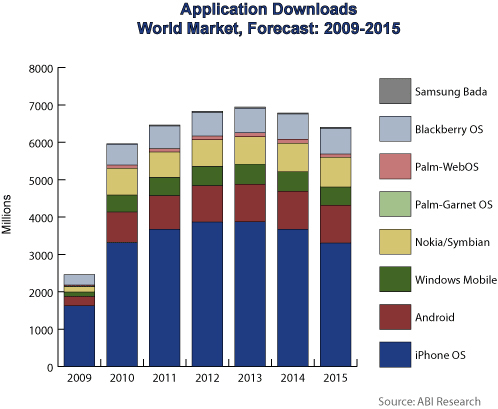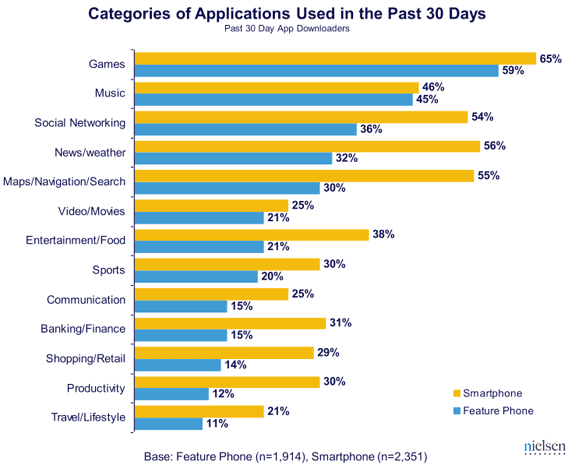Do you have an app strategy? 5 options for reaching and engaging your audience through mobile applications
I'm currently updating my books on the latest developments and thinking through the options companies have for their mobile app strategy. This is where I've got to.
I'd be grateful for your opinions, particularly if you have experience of what works and what doesn't as a specialist consultant on mobile apps or if you are using apps within your business.
The growth in popularity of mobile apps
For me, the growth in popularity of apps for the iPhone has been amazing with Apple announcing in January 2010 that 3 billion apps had been downloaded in the 18 months following the launch of the AppStore. Growth has been maintained through 2010:

Growth in download from Apple App Store 2010. Source: IphoneDev
The figures in the chart above from iPhoneDev are compiled a summary of the growth based on official figures from the Apple App Store and showed these fascinating characteristics of Apps from the App Store in June 2010:
- Number of apps downloaded per month = 500M
- The number iOS users = 100 Million
- Average number of apps downloaded by an iOS user = 5 per month
- Of which paid apps are 25% i.e. 1.25 apps
- Average spend by an iOS user = 1.25*$1.25 = $1.5 per month
- Total paid apps sales amount = $1.5*100M = $150M
Popularity of apps by operating system
Of course, the Apple App Store has grabbed a lot of the headlines, and rightly so, but there are many rival smartphone operating systems which are worth considering. This compilation from ABI research shows a clear prediction that the Android will be in second place, but significantly behind the iPhone with others such as Nokia/Symbian and Blackberry OS not far behind. So if you have to select one OS, Apple is a clear winner. But there may be case where other audiences should be considered. For example, I noticed that Tesco recently launched a Nokia Grocery App (http://www.tesco.com/apps/) in advance of it's iPhone app to reach the substantial audience of non iPhone users.

Mobile app strategy options
I think think the main mobile app strategy decisions are:
Q1. Are apps a strategic priority for us? The goal of apps for most organisations will be to increase awareness and sales, or for publishers revenue from advertising or subscriptions.
For many companies, this won't be a priority because they will have to put budget into higher priority areas such as improving the experience on site or in their social network presence. Owing to volume of users reached through these other platforms incremental improvements here are likely to give better returns. But the figures presented above show the potential benefits of apps to marketers in reaching audiences and potentially in selling apps, although the latter will be generally limited to publishers or specialist software developers. For these types of organisations, apps are likely to be a priority.
Q2. Do we build our own app and/or leverage existing apps ? Creating an app is only one of the marketing options - advertising and sponsorship options may be a more cost-effective method to build reach and awareness of a brand. A good example of sponsorship fit is the Canon Sponsorship of the excellent Guardian Eyewitness phototgraphy app. We also have the new in-app advertising including iAds from Apple and Google Adsense equivalents (made possible through its acquisition of the AdMob network) although I'm not sure of any results from those yet.

Q3. Free or paid apps? Retailers will generally offer free apps offering choice and convenience in return for loyalty. Brands offering entertainment will likely also go the free route to increase customer engagement. But for publishers or software houses, a freemium approach of free app showcasing the serivce and paid app for improved features or content is the standard approach.
Q4. Which category of application to target? As you would expect, accessing social networks and music via apps is popular, but for most organisations, you can see from the chart below that Games and Entertainment are the main options.

- Popularity of Mobile App categories 2010. Source: Nielsen State of Mobile Apps 2010
Q5. How to best promote mobile apps? Your options for marketing apps are illustrated well by this chart of preference for finding out about apps for smartphones which shows that the most popular methods of app discovery are
- 1. Searching the app store
- 2. Recommendations from friends and family
- 3. Mention on device or network carrier page
- 4. Email promotion
- 5. Offline mention in TV and print.
Q6. How to refine apps in line with feedback. The success of apps is very dependent on feedback in the App stores and the need to fix bugs and add enhancements to compete shows the need for an ongoing development cycle with frequent updates. A whole new area of app analytics and new solutions will no doubt develop but a challenge with apps similar to that of Flash apps before them is that measurement functionality needs to be specified in advance. Careful review of hurdle rates for % user base who are using the app or its different function is going to be a KPI here.
Marketing your mobile apps

If you'd like to read more detailed analysis of app usage, I'd recommend downloading the full Nielsen PDF on the State of Mobile Apps.
Please let me know your take on mobile apps - they're not something I've paid enough attention to so trying to address that!










